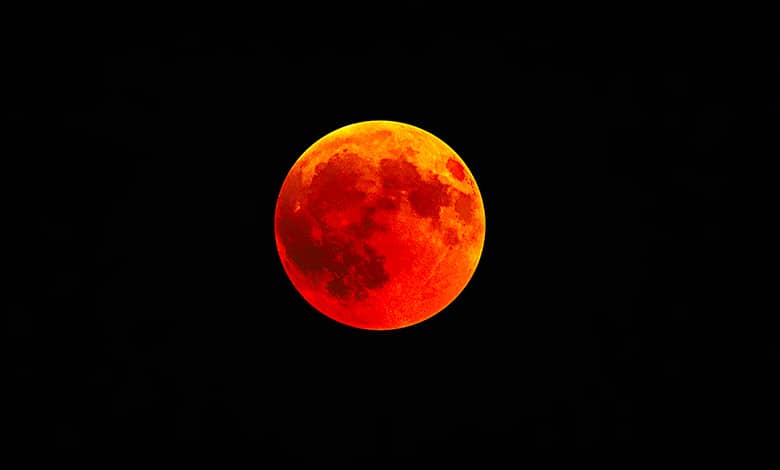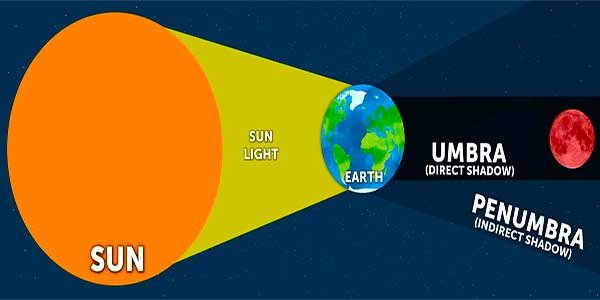
Hello, celestial observers and night sky enthusiasts! Ever wonder why the Moon sometimes swaps its usual silvery glow for a mesmerizing shade of red? You’re in for a cosmic treat! We’re unraveling the mystery behind this lunar phenomenon that has captivated humans for centuries. Whether you’ve witnessed this awe-inspiring sight firsthand or are eagerly awaiting your chance, join us as we travel through the shadows to discover why the Moon turns red.
Moon does not have a light of its own. Why? Didn’t he pay the electricity bill? Sunlight or white light is a mixture of visible colors. The sunlight reflects all these visible colors when it falls on the moon. Making the moon mostly appear white. However, the moon appears red when the earth is precisely between the sun and the moon during a lunar eclipse. It happens because of the earth’s atmosphere.
When sunlight comes from the sun and passes through the earth’s atmosphere, the earth’s atmosphere scatters the colors of the sunlight, giving them shorter wavelengths. However, the red color, which has the longest wavelength, is the least scattered. Hence, it makes its way to the moon, making it look red.
Grab your telescope (or your imagination), and let’s dive into the celestial mechanics and atmospheric wonders that paint the Moon crimson during a lunar eclipse. Prepare to be illuminated by the beauty and science of our closest celestial neighbor!
Why Does The Moon Turn Red?
Blood Moon or Lunar Eclipse occurs during a lunar eclipse when the Earth aligns between the Sun and the Moon, causing the Moon to pass through the Earth’s shadow. Here’s why the Moon can appear red during a lunar eclipse:
Earth’s Atmosphere: During a lunar eclipse, sunlight passes through the atmosphere before reaching the Moon. Earth’s atmosphere scatters shorter wavelengths of light (blue and green) more than longer wavelengths (red and orange). This scattering phenomenon is similar to what causes the sky to appear blue during the day.
Rayleigh Scattering: The scattering of light in Earth’s atmosphere is mainly due to Rayleigh scattering. Rayleigh scattering is most effective for shorter wavelengths, so blue light is scattered more strongly than red light. The longer wavelengths, particularly red and orange, are less scattered and can pass through the atmosphere with less obstruction.
Atmospheric Conditions: The appearance of the Moon during a lunar eclipse can be influenced by the atmospheric conditions at the time. Factors such as dust, pollution, or volcanic activity in the Earth’s atmosphere can affect the degree of scattering and alter the color and intensity of the light reaching the Moon.
Reflection and Refraction: Once the red and orange light passes through the Earth’s atmosphere, it is refracted or bent towards the Moon. This refracted light reflects off the Moon’s surface to Earth, giving it a reddish hue.
Blood Moon happens when the Earth moves between the sun and the moon, causing the moon to be in Earth’s shadow fully. The moon gets that red because a bit of light from the Earth’s sunrises and sunsets makes its way over.
A full moon happens once a month. The Moon moves in a circle-shaped pathway around the Earth. The Sun’s light causes the Earth to have a shadow that goes out this way into space. Outer space is dark, so you usually can’t see the shadow. But sometimes, when the moon is over in this part of its pathway, it goes into the Earth’s shadow.

The shadow of the Earth blocks out the light from the Sun, so the Moon starts to go dark. It starts to look like it’s disappearing. What happens after the moon begins to go into the Earth’s shadow? How does the moon turn reddish-orange or red? It is because of the lunar eclipse and the blood moon happens.
During a lunar eclipse, the moon travels directly behind the Earth into the Earth’s shadow. The Moon’s surface, which looks white, would have reddish-orange light.
- A new moon is visible when its orbit is closest to the sun.
- A full moon is visible when its orbit is farthest from the sun.
If the Earth sits in the middle, why doesn’t Earth cast a shadow during every full moon?
The moon’s orbit around the Earth is tilted by a few degrees relative to our path around the sun. So, the Earth isn’t directly in the way during most full moons. But occasionally, that full moon happens right in the middle of Earth’s shadow. Lunar eclipses are pretty standard as astronomical phenomena go.
On average, there are about one and a half lunar eclipses per solar year, but that means anywhere from 0 to 3 because I’m not sure how you get half of an eclipse. Not every eclipse is the same. Like every orbit, the moon follows an elliptical path. A supermoon will become visible when a full moon lines up with its closest approach to Earth. The lunar face can appear up to 14% bigger and 30% brighter.
The opposite phenomenon, where the full moon happens at the farthest point, is called an apogee-syzygy. The sun is so much bigger than the Earth. We cast a two-part shadow on the moon. The penumbra is called the wider outer shadow, where the Earth only partially blocks the sun’s light.
The moon barely dims as it enters this part. The narrow shadow in the middle, where Earth blocks the sun’s light, is called the umbra. Temperatures on the moon can quickly fall from over 100˚C in the sun to -150˚C in Earth’s shadow.
A lunar eclipse from the moon looks like a solar eclipse from Earth during totality, where the moon is entirely inside Earth’s umbra. A bit of the sun’s light is bent through our atmosphere and comes out the other side. But along that journey, the air around us has filtered the shorter wavelengths. It’s the same reason sunsets and sunrises are red here on Earth.
When we stare at the red color of a lunar eclipse, we see every sunrise and sunset on Earth reflected at us simultaneously!
Through the shadows of Earth’s eclipses and the magic of Rayleigh scattering, we’ve journeyed together from the realms of ancient myth to the frontiers of modern science, uncovering the secrets behind this celestial spectacle. We hope this exploration has not only satisfied your curiosity but also deepened your appreciation for the dynamic and beautiful universe we’re a part of.
Thank you for joining us on this cosmic adventure. Until the Moon graces us with its next dramatic performance, keep your eyes on the skies and never stop marveling at the wonders above. Happy moon gazing!
More Articles:
Why Moon Is White With Colour Explanation
Why Does The Moon Look So Big & Different Size
References:
McClure, Bruce. “Century’s Longest Lunar Eclipse.” EarthSky.
Karttunen, Hannu. Fundamental Astronomy. Springer.
